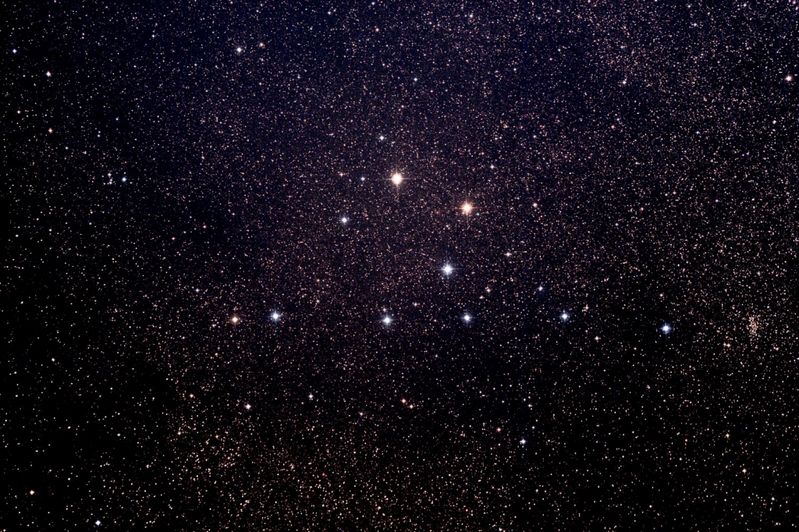The Night Sky
Summer / Autumn Binocular Highlights
While some objects in the night sky require the resolving power of a telescope, others are better viewed using the low-power and wide field of view of binoculars. Here are some favourites to test your navigation (and the steadiness of your hands!).
All of the objects are in the Summer Triangle, so let's find that first:
As darkness falls, the Summer Triangle rises in the south-east - this asterism is conspicuous in the night sky from now until November. The Summer Triangle is an imaginary triangle drawn from Deneb (in the constellation of Cygnus), to Vega (the brightest star in Lyra) and Altair (in the constellation of Aquila).

 Our first target is Albireo (Beta Cygni), with some justification, the double star against which all others are measured. Firstly, because the pair is reasonably easy to split - under clear skies, binoculars will show you Albireo as two stars. And secondly, notice the striking colour contrast between the two, with the brighter star gold and the dimmer star blue.
Our first target is Albireo (Beta Cygni), with some justification, the double star against which all others are measured. Firstly, because the pair is reasonably easy to split - under clear skies, binoculars will show you Albireo as two stars. And secondly, notice the striking colour contrast between the two, with the brighter star gold and the dimmer star blue.
Albireo also has the advantage of being very easy to locate, at the opposite end of the Swan's body from Deneb.
 Our second object is the perfect binocular target - it is too large to be seen satisfactorily in the small field of view of a telescope. Under a dark sky, Brocchi’s Cluster (Collinder 399) can be seen with the naked eye as an unresolved patch of light; binoculars are needed in order to view the "coat-hanger" asterism.
Our second object is the perfect binocular target - it is too large to be seen satisfactorily in the small field of view of a telescope. Under a dark sky, Brocchi’s Cluster (Collinder 399) can be seen with the naked eye as an unresolved patch of light; binoculars are needed in order to view the "coat-hanger" asterism.
Find the small constellation of Sagitta (the Arrow) above Altair and pan a little to the right and up - the Coat-hanger should be spotted easily against a darker region of the Milky Way.
The asterism is made up of 10 stars ranging from 5th to 7th magnitude which form the conspicuous "coat-hanger", a straight line of 6 stars with a "hook" of 4 stars on the south side. An additional 30 or so fainter stars are sometimes considered to be associated as well.
The asterism and its immediate surroundings are a useful gauge for determining the faintest stars visible in a small telescope as there are a wide range of stellar magnitudes within the cluster easily viewed in one small location of the sky.
The summer triangle contains two well known planetary nebulae, M27 (the Dumbbell nebula) and M57 (the Ring nebula): M57 has been described as a celestial smoke ring, is located south of Vega between Beta (ß) (Sheliak) and Gamma (γ) Lyrae (Sulafat), making it an easy target.
M27 is brighter and larger than M57 and closer to us at 1,360 light years. It is easier to spot than M57 and was in fact the first planetary nebula to be identified. It has been calculated that the original red giant star threw off its outer layers about 14,500 years ago, leaving its core behind as a white dwarf star that is the largest such star discovered to date.
Both nebulae appear as faint, fuzzy objects in binoculars, but bear with it - if the sky is dark and clear, additional detail will gradually emerge.
 The "E" or "Barnard's E" Nebula (officially designated as Barnard 142 and 143) is a pair of dark nebulae in the Aquila constellation. The dark dust and gas produce a well-defined dark area which blocks light from the stars of the Milky Way and give the nebula its distinctive “E” shape. Its size is about that of the full moon, or roughly 0.5 degrees – locate it by panning slowly and carefully just above Altair.
The "E" or "Barnard's E" Nebula (officially designated as Barnard 142 and 143) is a pair of dark nebulae in the Aquila constellation. The dark dust and gas produce a well-defined dark area which blocks light from the stars of the Milky Way and give the nebula its distinctive “E” shape. Its size is about that of the full moon, or roughly 0.5 degrees – locate it by panning slowly and carefully just above Altair.
